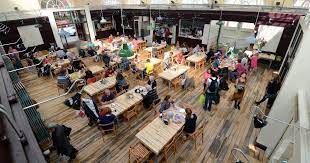Across European cities, a quiet shift in food culture is taking place. Traditional street vendors are moving indoors, joining a growing wave of urban food halls that combine local cooking with shared social spaces. The transformation is gradual, but it’s reshaping how people eat, work, and meet in public. And just as some unwind with casual entertainment like the lucky 7 game, others are finding the same simple satisfaction in these communal food spaces—places where convenience and culture meet without pretense.
From Markets to Halls: The Changing Urban Food Scene
Street food has long been part of Europe’s character. Markets once served as both grocery outlets and social hubs. Over time, urban planning, hygiene laws, and economic changes pushed many independent vendors aside. Now, the food hall movement is reversing that trend—by creating structured, indoor spaces where small food businesses can thrive under shared roofs.
Unlike traditional restaurants, food halls operate as open environments. Several independent kitchens work side by side, sharing tables, lighting, and foot traffic. The setup makes sense in cities where real estate is expensive but demand for informal dining remains high.
What’s emerging is not just a new kind of market, but a hybrid model: part social venue, part incubator, part cultural showcase.
Why Food Halls Work
Food halls succeed because they balance flexibility with order. Vendors keep their creative freedom, but they also benefit from stable infrastructure—utilities, seating, security, and marketing. Customers get choice without chaos: a variety of foods in one place, often open from lunch through late evening.
Economically, it’s an efficient model. Instead of competing for scarce street permits or long leases, vendors rent small units inside a shared complex. It reduces risk and encourages experimentation. A stall owner can test a new menu for months rather than committing to a full restaurant.
For cities, food halls also help reactivate underused buildings. Many occupy old factories, train stations, or warehouses that would otherwise remain empty. This reuse ties them to urban regeneration projects, linking commerce with culture.
The Social Dimension
Food halls are not just about eating; they’re about how people now spend their free time. They offer public seating, open layouts, and informal gathering spots that attract locals and tourists alike. In an age when remote work blurs the line between professional and personal life, food halls provide neutral spaces that fit both.
They also reflect a larger change in how Europeans interact with cities after hours. Instead of crowded nightlife districts or isolated cafes, food halls encourage mixed-age, mixed-purpose crowds. A family might eat dinner next to students having a drink or coworkers meeting casually after work. This blend of activity supports safer and more inclusive urban nights.
In this sense, food halls echo older European habits—public squares, shared meals, open conversation—but adapted to the pace of modern life.
The Culinary Impact
For chefs and small food entrepreneurs, the rise of food halls has opened new pathways. The barriers to entry are lower, and collaboration more common. Many vendors experiment with fusions or simplified menus that focus on quality ingredients and fast service.
This doesn’t mean fine dining is disappearing. Instead, it shows that people value variety over exclusivity. Diners can enjoy regional dishes, international flavors, or new twists on local classics—all within walking distance.
In this model, innovation comes from direct feedback. If a dish sells well, it stays. If it doesn’t, the cook adapts quickly. The loop between customer and creator is short and honest, more like a conversation than a transaction.
Cultural Integration and Tourism
Food halls have become part of Europe’s cultural branding. They appear in travel guides, drawing visitors who want an easy way to taste multiple cuisines in a short time. But for locals, they also serve as expressions of community identity.
Each city shapes its food halls differently. Some focus on regional heritage—cheeses, pastries, local produce—while others emphasize diversity, offering global street food under one roof. This adaptability helps them fit different cultural and economic settings.
Tourism plays a role, but not the leading one. The strongest food halls succeed because they attract repeat local customers. They are not pop-up attractions; they are sustainable parts of the city’s rhythm.
Challenges and Future Directions
Despite their success, food halls face growing pains. As they expand, questions of authenticity arise. Can a commercialized version of “street food” still represent local culture? When rent rises, small vendors may lose space to larger players.
Sustainability is another issue. Managing waste, sourcing ingredients locally, and keeping prices fair are ongoing struggles. Yet many food halls are addressing these challenges directly—through shared composting systems, local partnerships, or limits on disposable packaging.
Looking forward, food halls could evolve into multipurpose hubs: part dining space, part market, part community center. Some cities are experimenting with rotating vendor schedules or nighttime events to keep the model fresh.
Conclusion
The rise of food halls marks a shift in how Europe understands urban food culture. They combine the energy of street markets with the structure of modern retail, creating spaces that are both accessible and forward-looking.
Their growth reflects a deeper desire for connection—to food, to place, and to one another. Whether in a converted train station or a neighborhood warehouse, these halls tell a story of adaptation: how traditional habits can survive by changing form.
In the end, the food hall is not a passing trend but a sign of how cities continue to reinvent the simple act of eating together.

